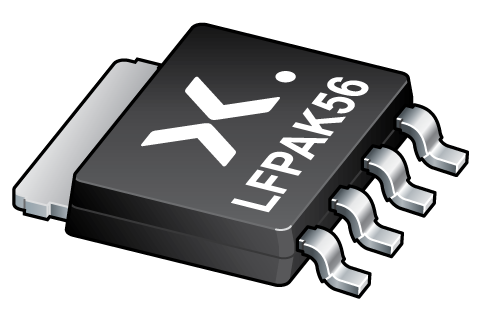
Register once, drag and drop ECAD models into your CAD tool and speed up your design.
Click here for more informationPSMNR73-25YLH
N-channel 25 V, 0.87 mΩ, 280 A logic level MOSFET in LFPAK56 using NextPowerS3+ Technology
Logic level gate drive N-channel enhancement mode MOSFET in LFPAK56 package. NextPowerS3+ portfolio utilising Nexperia’s unique “SchottkyPlus” technology delivers high efficiency, low spiking performance usually associated with MOSFETs with an integrated Schottky or Schottky-like diode but without problematic high leakage current. NextPowerS3+ is particularly suited to high efficiency applications at high switching frequencies.
Features and benefits
- 100% avalanche tested at I(AS) = 190 A
- Ultra low QG, QGD and QOSS for high system efficiency, especially at higher switching frequencies
- Superfast switching with soft-recovery
- Low spiking and ringing for low EMI designs
- Unique “SchottkyPlus” technology; Schottky-like performance with <1µA leakage at 25°C
- Optimised for 4.5 V gate drive
- Low parasitic inductance and resistance
- High reliability clip bonded and solder die attach Power SO8 package; no glue, wire bonds, qualified to 175 °C
Wave solderable; exposed leads for optimal visual solder inspection
Applications
- On-board DC:DC solutions for server and telecommunications
- Secondary-side synchronous rectification in telecommunication applications
- Voltage regulator modules (VRM)
- Point-of-Load (POL) modules
- Power delivery for V-core, ASIC, DDR, GPU, VGA and system components
- Brushed and brushless motor control
- Power OR-ing
Parametrics
| Type number | Package version | Package name | Product status | Channel type | Nr of transistors | VDS [max] (V) | RDSon [max] @ VGS = 10 V (mΩ) | RDSon [max] @ VGS = 4.5 V; @25 C (mΩ) | Tj [max] (°C) | ID [max] (A) | QGD [typ] (nC) | QG(tot) [typ] @ VGS = 4.5 V (nC) | QG(tot) [typ] @ VGS = 10 V (nC) | Ptot [max] (W) | Qr [typ] (nC) | VGSth [typ] (V) | Automotive qualified | Ciss [typ] (pF) | Coss [typ] (pF) | Release date |
|---|---|---|---|---|---|---|---|---|---|---|---|---|---|---|---|---|---|---|---|---|
| PSMNR73-25YLH | SOT669 | LFPAK56; Power-SO8 | End of life | N | 1 | 25 | 0.87 | 1.26 | 175 | 280 | 12 | 34 | 71 | 224 | 33 | 1.7 | N | 4265 | 2961 | 2018-02-22 |
Package
All type numbers in the table below are discontinued.
| Type number | Orderable part number, (Ordering code (12NC)) | Status | Marking | Package | Package information | Reflow-/Wave soldering | Packing |
|---|---|---|---|---|---|---|---|
| PSMNR73-25YLH | PSMNR73-25YLHX (934660508115) |
Obsolete | H7025L |

LFPAK56; Power-SO8 (SOT669) |
SOT669 |
REFLOW_BG-BD-1
WAVE_BG-BD-1 |
SOT669_115 |
Environmental information
All type numbers in the table below are discontinued.
| Type number | Orderable part number | Chemical content | RoHS | RHF-indicator |
|---|---|---|---|---|
| PSMNR73-25YLH | PSMNR73-25YLHX | PSMNR73-25YLH |
|
|
Series
Documentation (8)
| File name | Title | Type | Date |
|---|---|---|---|
| AN90063 | Questions about package outline drawings | Application note | 2025-03-12 |
| SOT669 | 3D model for products with SOT669 package | Design support | 2017-06-30 |
| Nexperia_package_poster | Nexperia package poster | Leaflet | 2020-05-15 |
| LFPAK56_POWER-SO8_SOT669_mk | plastic, single-ended surface-mounted package; 4 terminals; 4.9 mm x 4.45 mm x 1 mm body | Marcom graphics | 2017-01-28 |
| SOT669 | plastic, single-ended surface-mounted package; 4 terminals | Package information | 2025-03-20 |
| REFLOW_BG-BD-1 | Reflow soldering profile | Reflow soldering | 2021-04-06 |
| TN00008 | Power MOSFET frequently asked questions and answers | Technical note | 2024-08-09 |
| WAVE_BG-BD-1 | Wave soldering profile | Wave soldering | 2021-09-08 |
Support
If you are in need of design/technical support, let us know and fill in the answer form we'll get back to you shortly.
Longevity
The Nexperia Longevity Program is aimed to provide our customers information from time to time about the expected time that our products can be ordered. The NLP is reviewed and updated regularly by our Executive Management Team. View our longevity program here.
Models
| File name | Title | Type | Date |
|---|---|---|---|
| SOT669 | 3D model for products with SOT669 package | Design support | 2017-06-30 |
How does it work?
The interactive datasheets are based on the Nexperia MOSFET precision electrothermal models. With our interactive datasheets you can simply specify your own conditions interactively. Start by changing the values of the conditions. You can do this by using the sliders in the condition fields. By dragging the sliders you will see how the MOSFET will perform at the new conditions set.